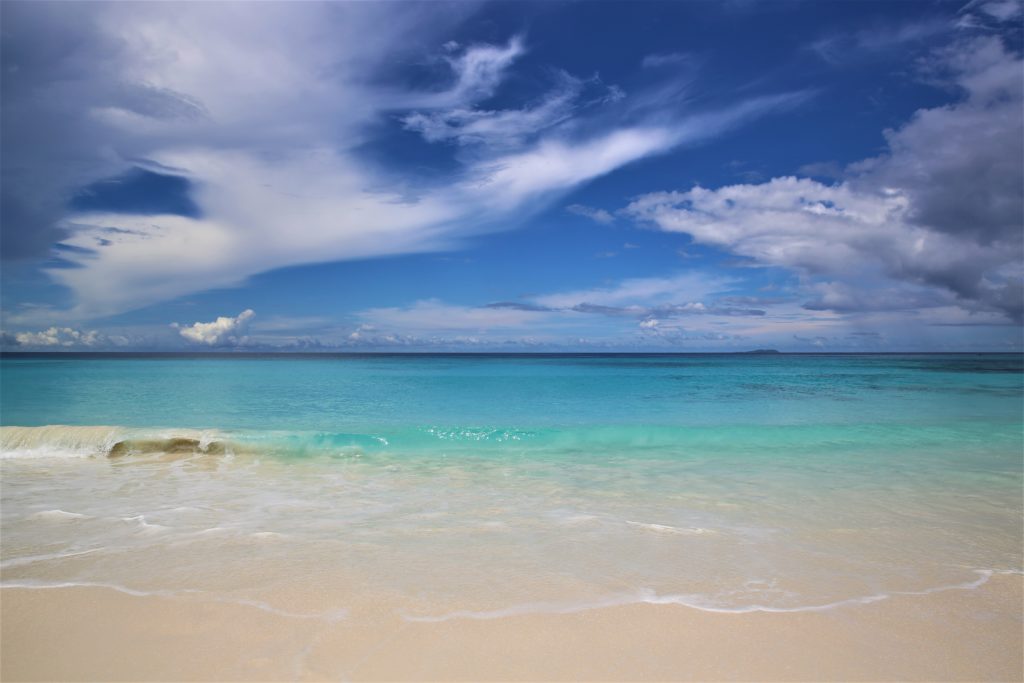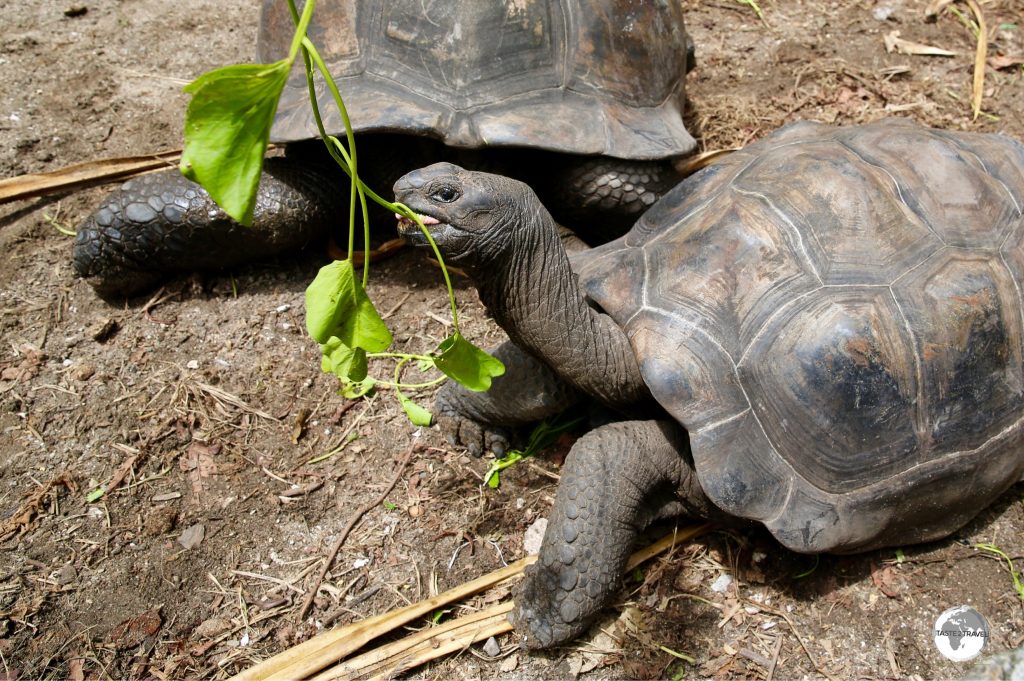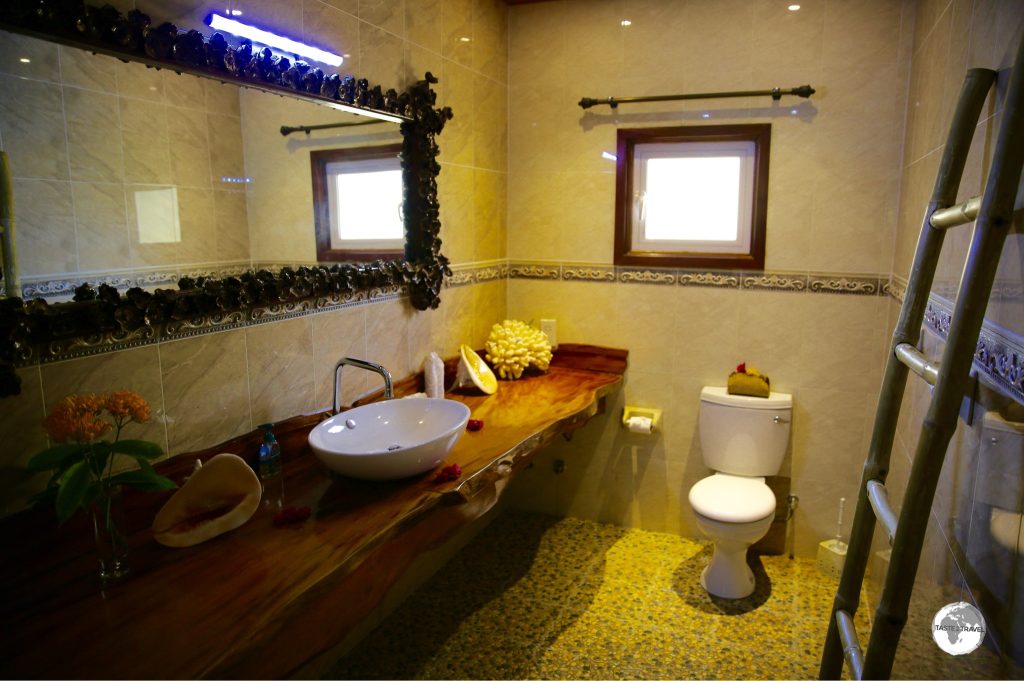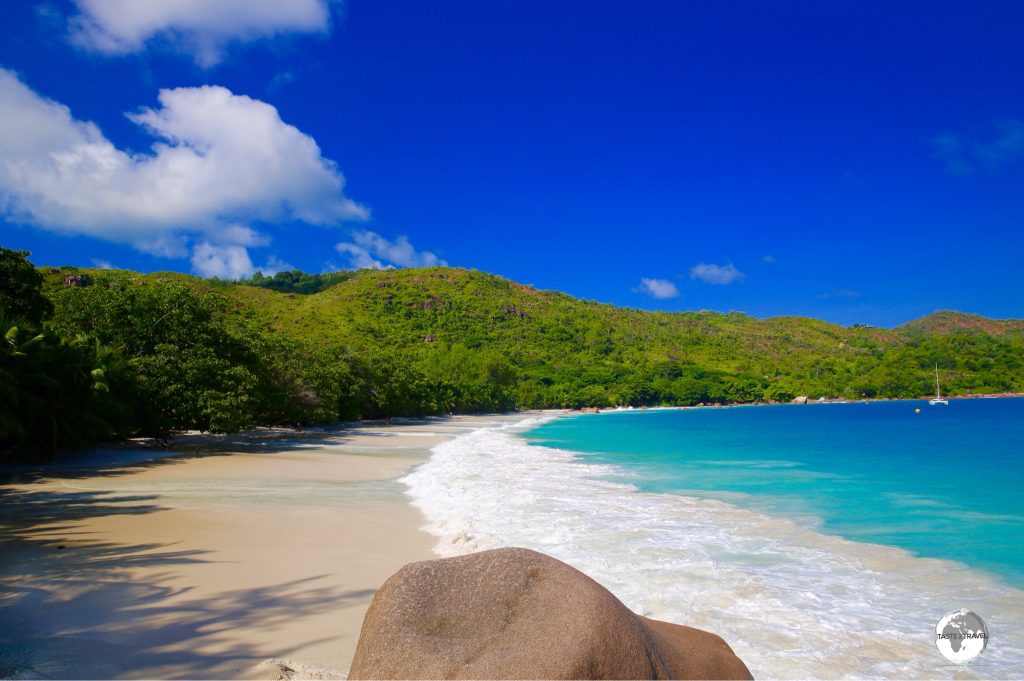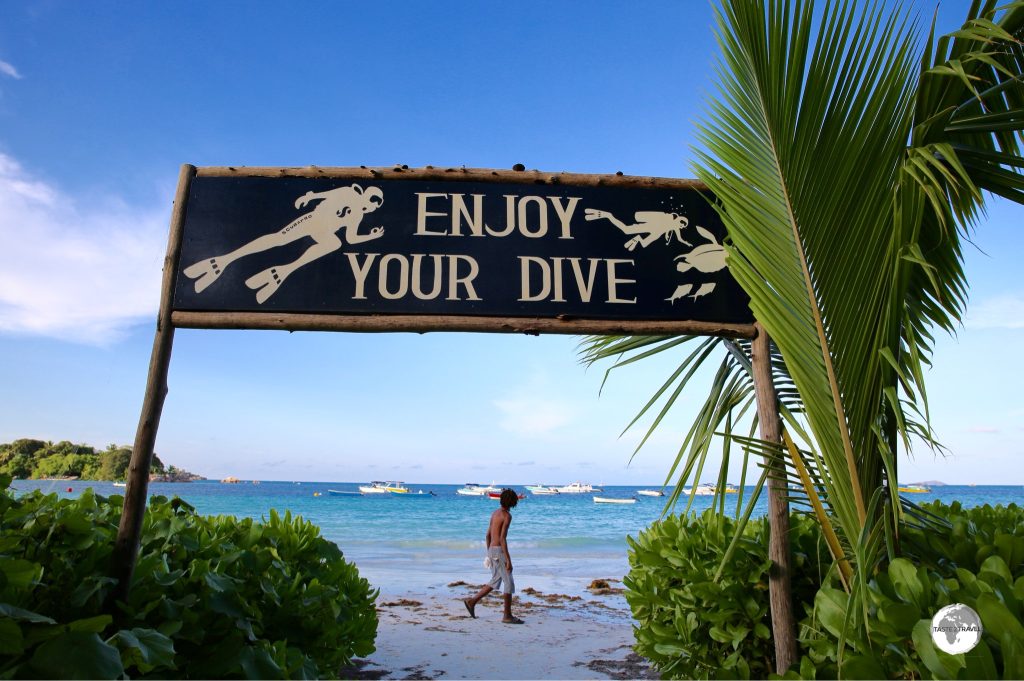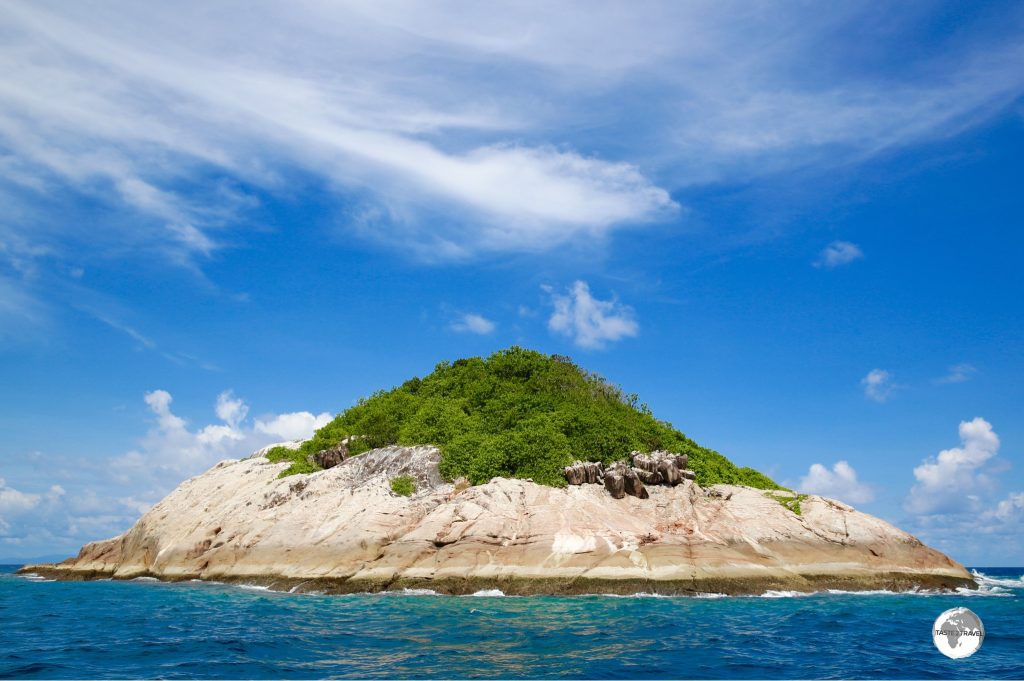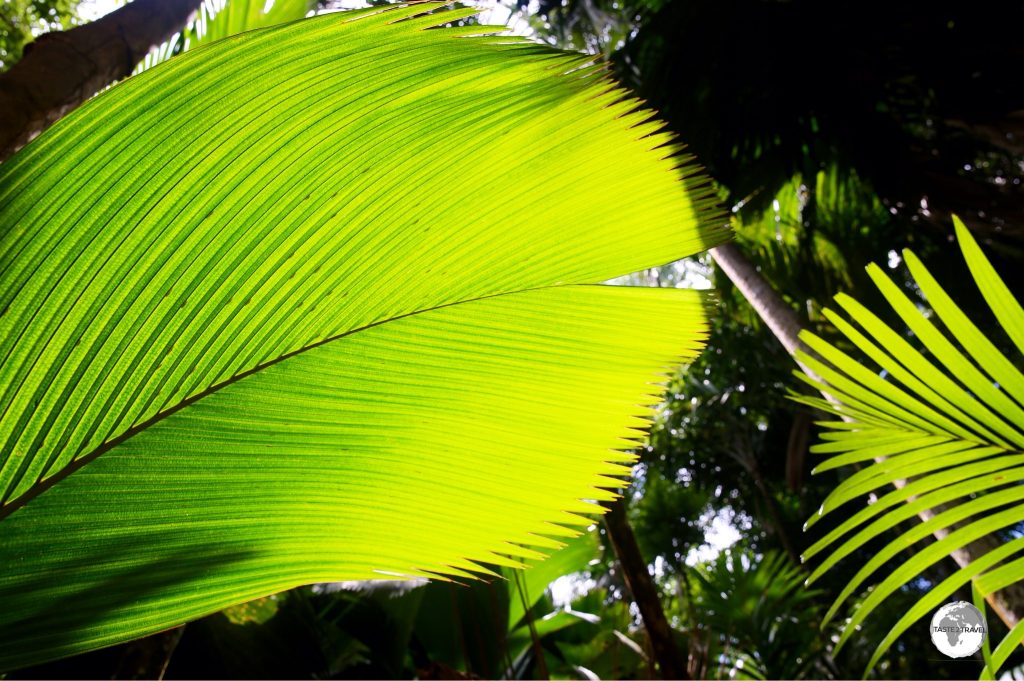Seychelles Travel Guide
Welcome to the taste2travel Seychelles Travel Guide!
Date Visited: April 2019
Introduction
Home to some of the most spectacularly beautiful beaches on planet Earth, the Seychelles is a magical destination which will cast a spell over anyone who ventures to her shores.

Located on Praslin island, Anse Lazio beach is sublimely beautiful in the early morning light.
Officially the Republic of Seychelles, the country is an island nation which sits in the Indian Ocean, 1,600 km (994 mi) off the east coast of Africa. The 115 idyllic, Granitic islands of this pristine archipelago nation are considered some of the oldest on earth. Once part of the ancient super-continent of Gondwana, it’s believed the islands have been separated from other continents for 75 million years.

Souvenir shop at the Takamaka distillery on the island of Mahé.
Home to 90,000 inhabitants, most of the islands remain uninhabited, while 99% of the population live on the three main islands of Mahé, Praslin and La Digue, all of which are covered in this report.

The Coat of arms of the Seychelles on display at the National Museum of History in Victoria.
Mahé is the largest island, the only entry point to the Seychelles, and home to the capital city of Victoria. While I enjoyed exploring Mahé, the highlights for me were the two smaller islands of Praslin and La Digue, both exquisite and both a short boat ride away.

The many terracotta-coloured, granite boulders provide a stark contrast against the turquoise waters and blue skies of the Seychelles, such as this one on Anse Lazio, Praslin Island.
What’s so strikingly unique about the Seychelles are the giant granite boulders which dot the landscape. It’s these boulders which add a certain surreal magic to the many beaches as they contrast so starkly against the white-sand, turquoise water and brilliantly blue skies.
It’s largely because of these ancient stones that the beaches of the Seychelles are often voted the most beautiful in the world, which is the case with the mesmerisingly beautiful Anse Source d’Argent (cover photo) on the tiny island of La Digue.
While there’s no denying the beauty of this beach, there are many others, nearby, which are just as incredible. One of my favourites is Petite Anse which is located on La Digue, a short bicycle ride from Anse Source d’Argent. On each of the three main islands, you will find breath-taking beauty, even away from the famed beaches.

The Vallée de Mai Nature Reserve is the best place to see the endemic ‘Coco-de-mer’ palm.
One of the non-beach highlights for me was a visit to the Vallée de Mai Nature Reserve, which is located on the island of Praslin and is one of two UNESCO World Heritage sites in the Seychelles. The park is home to the world’s largest population of the native ‘Coco-de-mer‘ palm, which produces the largest coconut in the world.

With tourism being the main source of income, the environment on the Seychelles is always kept pristine.
The Seychelles market’s itself as a deluxe holiday destination and as such, travel costs are not cheap. This is not a budget destination and, while travelling around the country, I didn’t meet any backpackers.
Most visitors to the Seychelles are well heeled Europeans who come either for a holiday or their honeymoon. Tourism is the #1 economic activity for the country, contributing to 67% of GDP in 2018. The islands, and environment, are kept pristine by a government who appreciates the value that tourism brings to the country.

Grand Anse on the island of La Digue, just one of many stunning beaches to be found in the Seychelles.
If you have the budget and wish to explore a special destination, one which offers spellbinding scenery, a unique Creole culture, and a high degree of convenience and comfort, the Seychelles is for you.
Location
Victoria, Seychelles
An African nation, which boasts the highest standard of living in Africa, the Seychelles lies 1,600 km (994 mi) east of Kenya; 1824 km ( mi) northeast of Madagascar; 1,755 km (1,090 mi) north of Mauritius (click the links to view my guides); 1,826 km (1134 mi) north of Réunion and 1,450 km (900 mi) northeast of Mayotte.

The view from Beau Vallon beach towards Silhouette Island.
While the country encompasses an area of 1,336,559 square km (516,048 square mi), the landmass equates to just 452 square km (175 square mi).
Currency

The front of the Seychelles 50 rupee note features the Black Parrot.
Issued by the Central Bank of Seychelles (CBS), the Seychellois rupee (Rs) is the official currency of the Seychelles. In December of 2016, the CBS issued a new family of notes and coins which feature endemic fauna and flora.
The currency trades under the international code of SCR and is currently trading at a rate of USD$1 = 13.70 SCR.

The back of the Seychelles 50 rupee note features the Seychelles Tree Frog.
The rupee, which is divided into 100 cents, constitutes four notes in denominations of Rs 25, Rs 50, Rs 100 and Rs 500. Coins are issued in denominations of 1¢, 5¢, 10¢, 25¢, Rs 1 and Rs 5. Prices for tourist services are often quoted in Euro (€).
Tip: When leaving the country, it’s best not to carry anything more than a few souvenir notes as it’s impossible to exchange the rupee outside of the Seychelles.
Costs

At just US$20, a bottle of Coconut rum from the folks at the Takamaka distillery is an affordable souvenir of the Seychelles.
Travel costs are not cheap in the Seychelles. Like neighbouring Mauritius, tourism is the main economic activity, with the country catering to mid-range and top-end tourists. Travelling on a budget can be challenging, however, self-catering, Airbnb apartments are a saviour for more frugal travellers, although these can cost upwards of US$100.
Despite having a small agricultural sector, Seychelles imports 90% of the food it consumes, which results in high food prices in supermarkets and in restaurants. While most restaurant menus feature shrimp, which tourist’s love to order, almost all shrimp is imported.
Suggested daily budgets:
- Backpacker: Up to USD$160 per day.
- Flashpacker: Between USD$160-$330 per day.
- Top-End: USD$330+
Sample costs:
- Coca Cola (0.33 litre bottle): Rs 26 (US$1.90)
- Water (0.33 litre bottle): Rs 17 (US$1.25)
- Cappuccino: Rs 56 (US$4.11)
- Bus ticket with SPTC: Rs 7 (US$0.51)
- Car Rental (daily compact car with Hertz): Rs 890 (US$65)
- Litre of fuel: Rs 19 (US$1.39)
- Meal (inexpensive restaurant): Rs 250 (US$18.30)
- Meal for 2 (mid-range restaurant): Rs 1,000 (US$73.00)
- Self-catering apartment (La Villa Therese, Anse Royale): Rs 1,300 (US$95)
- Room in a top-end hotel (Four Seasons Seychelles): Rs 20,500 (US$1,500)
Philately

This definitive stamp from 2012 makes for an affordable souvenir at just US$0.15 each.
Stamps from the Seychelles are popular among philatelists worldwide, with many issues featuring the colourful fauna and flora of the islands.

The colourful marine life of the islands is a popular subject for stamp issues.
Affordably priced stamps, which make unique souvenirs and gifts, can be purchased from the friendly staff at the Seychelles Post Philatelic bureau, which is located inside the Central Post Office, on Independence Ave, opposite the Seychelles National museum.
People

Shopping in Victoria.
Although the islands of the Seychelles were known to Portuguese and Arab sailors, the archipelago remained uninhabited until the first settlers arrived on board the French ship Thélemaque, which landed on Mahé on the 27th of August 1770 from Mauritius (another French colony at the time).
The French established plantations on Mahé, importing large numbers of African, creole, slaves from Mauritius to the Seychelles. These slaves became the ancestors of the present population and today, the descendants of these slaves constitute 70% of the entire population.
Under the French and British, a number of Indian slaves, and later, indentured labourers were introduced into the mix and today the descendants of these labourers constitute 1/8th of the total population.
Flag
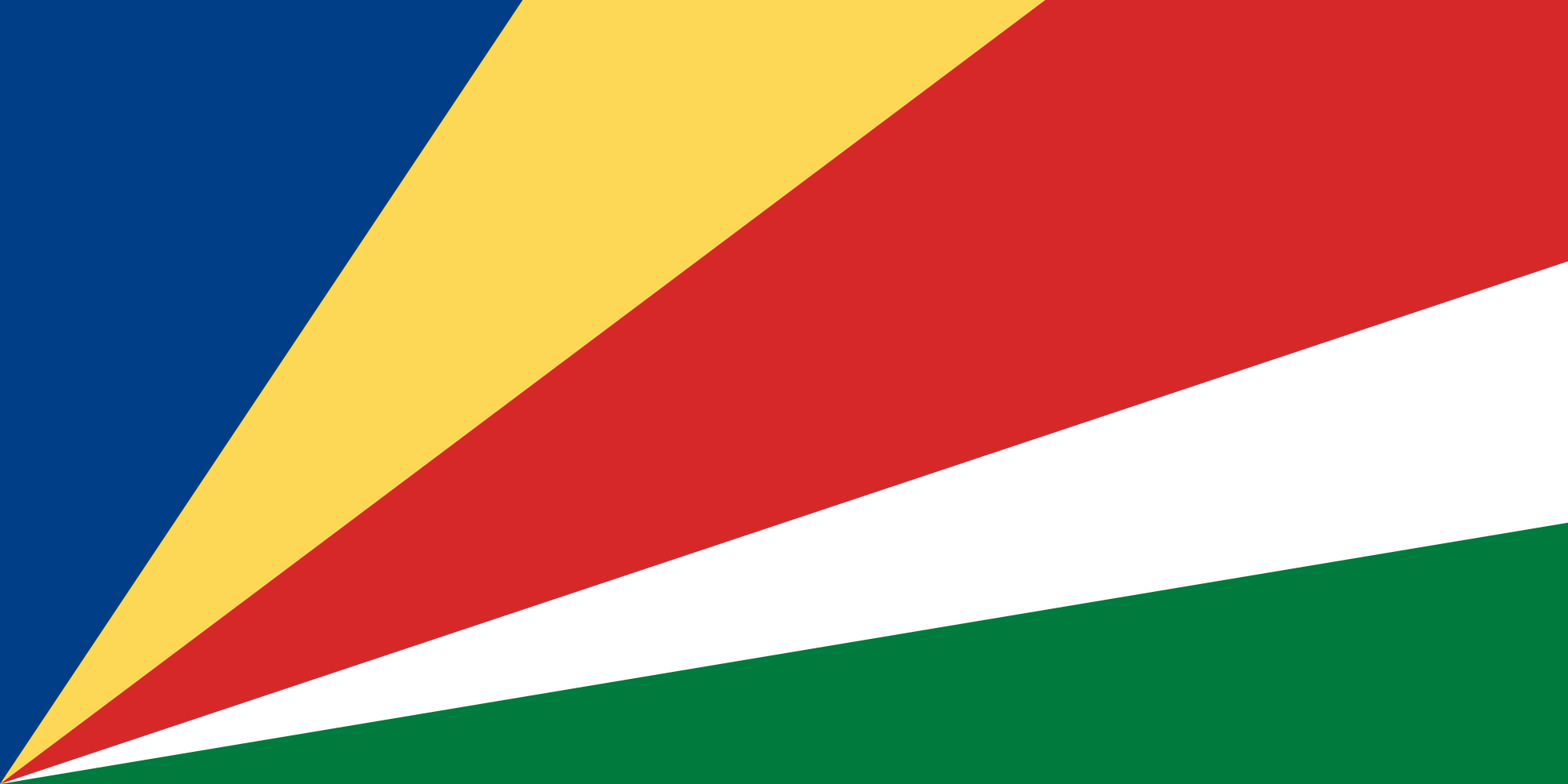
The flag of the Seychelles.
If you have an interest in vexillology, you’ll be interested to know that the flag of the Seychelles features five oblique bands of blue, yellow, red, white and green radiating from the bottom of the hoist side. The colours represent:
- Blue: depicts the sky and the sea that surrounds the Seychelles.
- Yellow: depicts the sun which gives light and life.
- Red: symbolises the people.
- White: represents social justice and harmony
- Green: depicts the land and natural environment.
Sightseeing
Mahé

The best way to explore the quiet back roads of Mahé is with a rental car.
Victoria
With a population of 26,000 inhabitants (a quarter of the total population), Victoria is the capital and largest city of the Seychelles. Situated on the north-eastern coast of Mahé, this small capital was originally established by the French, who called it L’Etablissement, it was renamed by the British, in 1841, after Queen Victoria.
A small and compact city, the sights of Victoria can be covered on foot in less than a day. The narrow streets of the downtown area were clearly created in the days of horse and buggy, and today, are constantly jammed with traffic. The narrow roads don’t allow space for parking and there are no multi-level municipal car parks. Parking spaces, which are extremely limited, can be found in a few, ground-level parking lots, most of which are permanently full of cars, belonging to local commuters. It is a nightmare to arrive by car, much better to take the bus.
Clock Tower

A busy roundabout, the clock tower stands at the centre of the capital Victoria.
The focal point of downtown Victoria is the antique, silver clock tower which stands at the centre of town and serves as a busy roundabout. Modelled on London’s Little Ben, Lorloz, as it’s locally known, was erected in 1903 when the Seychelles became a Crown colony.
National Museum of History

The National Museum of History is housed in the former colonial-era Supreme court building.
Housed in the restored, former Supreme Court building (1885), the National Museum of History was reopened in 2018 following a complete refurbishment.
This modern museum uses technology and digital, interactive, displays to tell the history of the Seychelles. The outstanding displays cover political, economic and social aspects along with Creole culture and national emblems.
Access: Open every day except Sunday. Tickets cost Rs 150 (USD$11) for tourists.

The National Museum of History tells the story of the Seychelles through colourful artworks by local artists.
St. Paul’s Anglican Church

The window above the narthex of St. Paul’s features Jesus floating above a typical Seychellois island with granite boulders, palm trees and an Aldabra giant tortoise.
Located a short walk from the clock tower, the non-descript exterior of the unassuming St. Paul’s Cathedral belies its interesting interior. Originally consecrated in 1859 by the first Bishop of Mauritius, the current church, which serves as the seat of the Bishop of Seychelles, dates from 2004.
What makes this cathedral worth visiting are the numerous, very colourful, stained-glass windows which depict religious scenes in a distinctly Seychellois setting. The presence of these truly local works of art are not apparent from the exterior, with most tourists passing by the church without entering

Another colourful window depicts ‘Madonna and Child’ in a typical Seychellois setting, on a white-sand beach surround by palm trees and granite boulders.
As you enter the church, it’s easy to miss the large window, above and behind your head, which shows Jesus floating above a typical white-sand, Seychelles beach, surrounded by palm trees, the ubiquitous granite boulders and even an Aldabra giant turtle. If you do miss Jesus when entering, you will not miss him when exiting as he looms large over you.
Elsewhere, the classic ‘Madonna and Child’ appears on a white-sand beach, surrounded by palm trees and more granite boulders. There are many more windows which are just as photogenic.
Sri Navasakthi Vinayagar Temple

Dedicated to Ganesh, the Sri Navasakthi Vinayagar Temple is the only Hindu temple in the Seychelles.
Located on Quincy street, a short walk from St. Paul’s, is the strikingly beautiful Sri Navasakthi Vinayagar Temple, the only Hindu temple in the Seychelles. The temple serves as a centre of worship for the members of the local Hindu community, most of whom originate from Tamil Nadu in India.

A shrine at the Sri Navasakthi Vinayagar Temple.
Consecrated in 1992, the temple is dedicated to Ganesh, who makes numerous appearances on the striking multi-tiered tower above the main door. The tower is inspired by the Dravidian architecture of Southern India, which is prominent in Tamil Nadu. The temple is free to visit, provided you remove your shoes.
Sir Selwyn Selwyn-Clarke Market

The Sir Selwyn Selwyn-Clarke Market is a great place to buy local produce and souvenirs.
Opposite the Hindu temple is the sprawling, bustling central market, the Sir Selwyn Selwyn-Clarke Market. Originally built in 1840, the market is named after a former British Governor of the Seychelles, who governed from 1947–1951.
The market is the bustling heart of the capital and is the best place to buy produce and locally made souvenirs (much cheaper here than elsewhere). The market is built on two levels, with produce stalls on the ground floor (including local spice shops), and restaurants and souvenir boutiques on the upper floor.
Beau Vallon

Beau Vallon is famous for its spectacular sunsets.
Located on a long stretch of sand on the north-west coast, the tourist hub of Beau Vallon is arguably the island’s most famous and popular beach, with white sand stretching for kilometres along the coast.
Located a short (15 min) drive over a steep hill from Victoria, Beau Vallon is home to many restaurants, resorts, hotels, guest houses, Airbnb properties and one nightclub. If you wish to stay somewhere with all the usual tourist facilities, this is the place.

A traditional fishing boat on Beau Vallon beach.
This beach-side playground is famous for its long sandy beach, spectacular sunsets and lively nightlife – well – lively for the Seychelles. If you’re looking for nightlife, Beau Vallon is the only place on Mahé which parties after dark.

The silhouette of Silhouette island, as seen from Beau Vallon beach.
Thanks to the clear waters of the bay, and the coral reefs, Beau Vallon is the best place on Mahé for snorkelling and diving, with numerous dive shops located along the beach front.
Lying 20-km offshore is Silhouette Island, which is the third largest granitic island in the Seychelles. The island is home to 200 souls who work at the exclusive Hilton Seychelles Labriz Resort & Spa where rooms cost around US$500 per night.
Takamaka Rum Distillery

The Takamaka white rum is a popular mixer, used in many local cocktails.
Now to one of my favourite subjects – Rum!
Located on the east coast at historic La Plaine St. André, the Takamaka Rum distillery is the only producer of rum in the Seychelles, producing 8 different varieties using local ingredients, including spring water from the Vallée de Mai on Praslin and sugarcane from local growers.
Owned by the d’Offay family, the distillery is centred around a beautifully restored, Plantation house which was built by French settlers in 1792, as part of an estate which originally grew cinnamon and other spices. In 2002, the plantation house, which is a national heritage site, was leased by the family who then restored it to serve as the centrepiece of their Trois Frères Distillery. Today it houses a very fine cafe and gift shop.

A friendly staff member at Takamaka rum conducting a tour.
Next door to the house, the small distillery is open for tours which are very informative and entertaining. Tickets cost Rs 250 (USD$18.33), which includes a short tour and a rum tasting. Tours are conducted twice daily (11.30 am and 1.30 pm) from Monday to Friday.

Once squeezed of its juice, the leftover sugarcane is returned to the farmers to be used as fertiliser.
The rums produced by the distillery are very quaffable and can be sampled all over the Seychelles, with most bars featuring Takamaka rum prominently on their cocktail lists. My pick of their range is their ‘Spiced‘ rum which is distilled using a secret combination of local spices, creating a very smooth and velvety character rum.
Anse Royale

With its shallow water, Anse Royale beach is a popular swimming beach on Mahé.
Continuing further south along the east coast, quiet Anse Royale is home to a stretch of small granite rock-fringed coves. The shallow waters and powdery white sand make the beaches popular with bathers.
There are numerous guest houses in the area, including La Villa Therese (see the ‘Accommodation‘ section below for more details) which was my first residence in the Seychelles.
Baie Lazare

A panoramic view over Baie Lazare, one of the finest beaches on the south-west coast of Mahé.
Baie Lazare is named after the French explorer Lazare Picault, who in 1742, landed on Mahé and claimed the island for France. The beach combines all the usual Seychelles elements, white sand, clear water and granite boulders, making it a popular destination for visitors and locals.
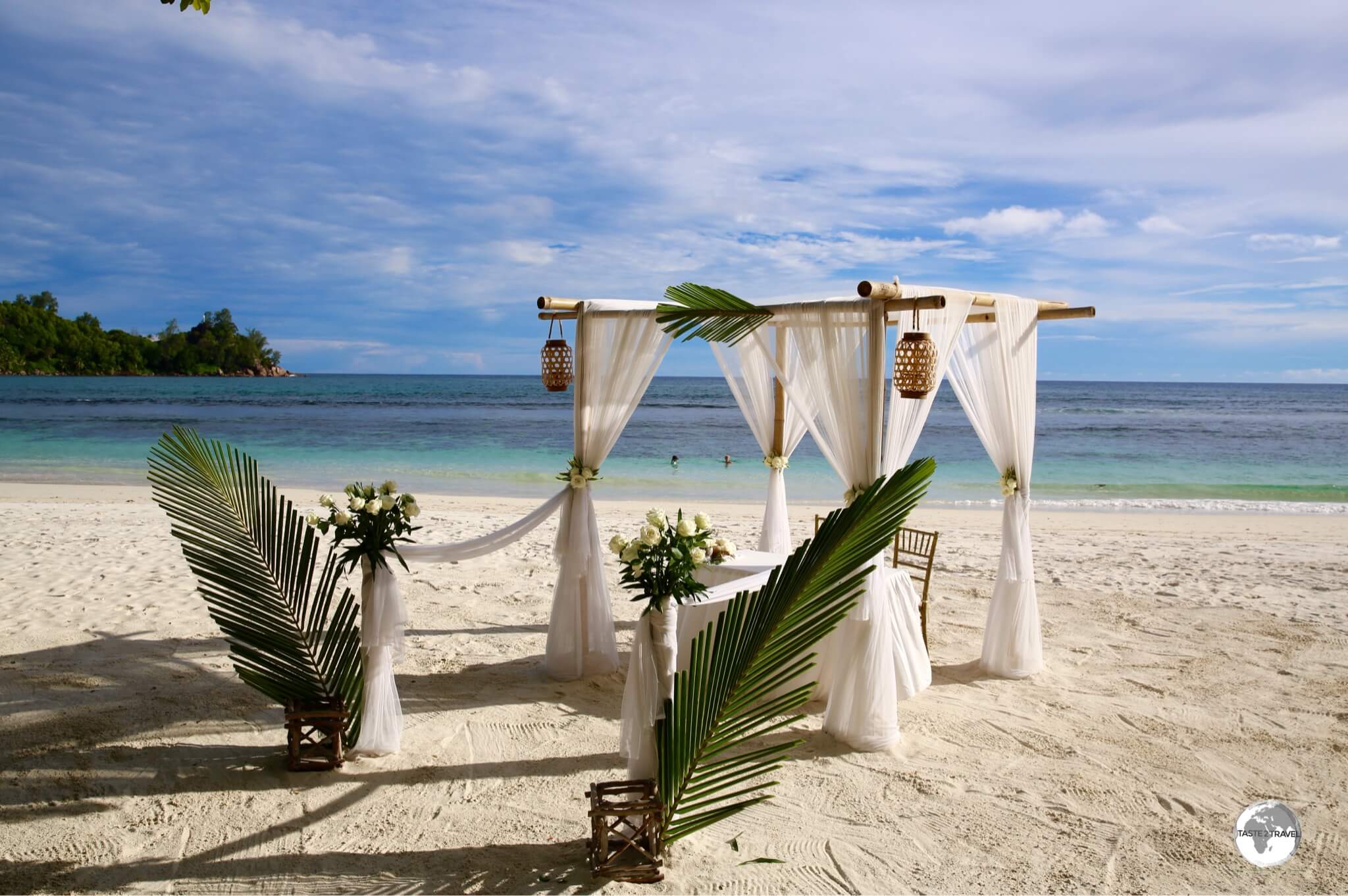
The Seychelles is a popular destination for weddings and honeymoons.
The largest resort in the area is the Kempinski Seychelles where a room will set you back almost US$1000 per night. The wide sandy beach of Baie Lazare is a popular wedding venue.

A view of Port Launay Marine Park on Mahé.
Towards the end of the road along the north-west coast, lies the very picturesque, Port Launay Marine Park. This large, horseshoe-shaped bay, is ringed by a white sand beach which is surrounded by lush, green vegetation. Being a protected marine park, snorkelling is excellent with an abundance of marine life. The deep waters of the bay make this a popular anchorage for visiting yachts.
The one resort in the area is the deluxe (of course!) Constance Ephelia where rooms start at US$500 per night.

Storm clouds over the Port Launay Marine Park.
Praslin
If you think the beaches on Mahé are beautiful, wait until you set foot on Praslin. The beaches here are on another level, with incredibly clear, turquoise water, the finest, whitest sand you could ever imagine and granite boulders which look like they have been deliberately placed by a landscape gardener.
Anse Volbert

Gorgeous Anse Volbert is the main tourist hub on Praslin.
Stretching for 2.5 km along the east coast, Anse Volbert beach is the longest on Praslin and the most popular. At low tide, the strip of sand is 6 metres wide, at low tide, the beach disappears. The white sand is the finest of any beach I’ve ever visited – anywhere! When wet the sand has the look and feel of a polished, white-marble floor.
The beach offers many activities including swimming, snorkelling, windsurfing, scuba diving, fishing, and sailing. Lining the beach are a string of restaurants, cafés, guest houses and boutique resorts. All of this combines to make Anse Volbert the most popular tourist destination on the island.
If you wish to hire a rental car, there are many agents in this neighbourhood (see the ‘Rental Car‘ section below for more details).
Scuba Diving

Some final advice from the owners of Octopus Diver prior to boarding the dive boat.
If you enjoy scuba diving, the seas around Anse Volbert offer some amazing dive sites and colourful reefs. I dived with Octopus Diver who operate a PADI 5-star dive shop which is located on the beach. The shop offers diving twice a day, with a two-tank diving costing €115 (USD$128).


On board the Octopus diver boat, heading to the first dive site.
Note: I was warned by the owners of my guest house to never give money to anyone on Anse Volbert beach who might claim to be representing a company which offers aquatic activities, even if these people are wearing a shirt from the company.
These fake salesmen are small-time criminals who make money by selling fake activities to unwitting tourists, who think they are paying a deposit on a service. The con-man then disappears with your money, leaving you holding some bogus receipt.
This criminal activity also affects Octopus Diver with reports on the internet from irate customers who believe they have been fleeced by a genuine employee of the shop.
You should only pay for any activities directly at the shop.

Booby Island gets its name from the numerous flocks of boobies who nest here.
I signed up for a two-tank dive, with the first dive taking place around Booby island. A perfectly round, cone-shaped, granite rock, the island is uninhabited and home to nesting boobies. The dive involved swimming around the island at a depth of 20 metres. An easy dive in terms of orientation!

Surface interval was conducted alongside Curieuse island.
The surface interval between dives took place at beautiful Baie Laraie which is the main landing point for visitors to Curieuse island. The entire island is designated as a national park and we were warned not to swim to shore, otherwise we would have to pay the park entrance fee of €70 (USD$77).
The second dive took place at a site near to St. Pierre island, which is another uninhabited granite rock, located between Praslin and Curieuse island. I would recommend diving with Octopus Diver.
Anse Lazio

The best time to photograph Anse Lazio is in the early morning before the tourist hordes arrive.
While Anse Source d’Argent is the must-see beach on La Digue, Anse Lazio is the must-see beach on Praslin. Located at the end of the road on the north-east coast, Anse Lazio combines a magical mix of elements – clear, turquoise water, golden sand, palm trees and huge granite boulders. It’s no wonder that, along with Anse Source d’Argent, this beach is also often voted as one of the most beautiful in the world.
Due to its popularity, the beach receives swarms of tourists, who head here once they’ve finished their hotel buffet breakfast. If you wish to photograph the beach, without lots of people, you need to arrive before 8 am.
Vallée de Mai

Offering numerous walking trails, Vallée de Mai is a remnant of an ancient palm jungle.
Located in the centre of Praslin, on the one cross-island road, is the Praslin National Park. The highlight of the park is the Vallée de Mai, which looks like a setting from Jurassic park.
The park is a remnant of an ancient palm jungle which dates from the days of Gondwana and is one of two UNESCO World Heritage sites in the Seychelles. A key attraction on Praslin, the park is open daily from 8 am to 5:30 pm with entrance tickets costing Rs 320 (US$26).

The world’s largest coconut, the Coco de mer is the national symbol of the Seychelles.
A series of walking trails meanders through the ancient forest, passing numerous, towering, Coco de Mer palms. While the park offers the best viewing opportunity in the Seychelles of these towering ancient giants, there are a total of 6 endemic palm trees which can be spotted from the walking trails.

One of many walking trails in the UNESCO-listed Vallee de Mai, a highlight of Praslin Island.
The largest seed in the world is the coco de mer, the seed of a palm tree. It can reach about 12 inches (30 cm) long, and weigh up to 40 pounds (18 kg).
Anse Takamaka

This lazy palm tree on Anse Takamaka appears on many postcards in the Seychelles.
Located on the south-west coast, Anse Takamaka appears on many postcards in the Seychelles for one reason – one lazy, but very photogenic, palm tree which seems to be reaching out towards the sea. The beach itself is long and protected and home to a small fleet of fishing boats.
Anse Georgette

Secluded Anse Georgette is ideal for snorkelling and swimming.
Yet another stunning beach! At the end of the road on the north-west coast is the very pretty Anse Georgette. Unfortunately, this secluded beach is located on the private property of the deluxe Constance Lemuria resort which presents some organisational challenges.
Although the beach is open to the general public, the resort imposes a daily limit on the number of visitors who are able to enter the property. If you wish to access the beach, you should contact the resort (Tel: +248 4281 281), at least one day in advance, and request that your name to be added to the ‘visitors’ list which is kept at the front guard house. If your name isn’t on the list, the guards can refuse entry, although the friendly guard allowed me to enter, even though I had not made any prior reservation.

The secluded and beautiful Anse Georgette is a worthwhile destination at the end of the road on the north coast of Praslin.
Once you arrive at the main gate, you’ll need to leave your car parked outside the resort grounds. From the security guard’s office, the beach is a 30-minute walk along a sweaty, hilly road. If you’re staying at the resort, you will be driven to the beach in a golf buggy.
Anse Georgette is yet another amazing beach and definitely worth the effort involved in getting there.
La Digue
Located 11-km (15 mins by boat) to the east of the much larger, and busier, Praslin, La Digue (population: 2,800) is the fourth largest granitic island in the Seychelles and is home to one of the world’s most photographed beaches, La Source D’Argent.
The island was named after a ship in the fleet of French explorer Marc-Joseph Marion du Fresne who visited the Seychelles in 1768. This tiny island (10 sq km / 3.8 sq mi) is mostly free of vehicles, which are restricted. Most locals, and tourists, either hire a bike or walk, making La Digue one very relaxed and chilled island.
Almost all facilities, including the port, accommodation, restaurants, shops etc are clustered along the beach in the main town of La Réunion.
Frequent ferries connect the island to the, much busier, Praslin, allowing hordes of day-trippers to visit. The masses start trickling onto the island around 8 am and depart by 4 pm, at which point the island becomes much quieter. The best time to photograph La Source D’Argent is outside of the day-tripping visiting hours.
The island offers a collection of truly stunning beaches, including the one everyone comes to photograph. While La Source D’Argent is beautiful, it is also over-run with tourists, all vying to take the most instagramable photo and a million selfies. I much preferred the quiet seclusion which is offered by the sister beaches of Grand Anse and Petite Anse, which are a short bicycle ride away on the south-east coast.
L’Union Estate Farm

The French-style Plantation house at L’Union Estate Farm was built by a family of Mauritian settlers.
For almost all visitors to La Digue, the one ‘must-see’ sight is the world famous La Source D’Argent beach, which draws tens of thousands of tourists every year. This photogenic wonder of nature is located on the private L’Union Estate Farm, which allows access to the beach (and the estate) during daylight hours for a fee of Rs 115 (USD$8.50).

The very handsome “La Digue day gecko”, which is endemic to the Seychelles, can be found on L’Union Estate Farm.
A relic from the colonial-era, L’Union Estate Farm was established by a family of Mauritian settlers as a coconut and vanilla plantation. The estate, which is today run like a small theme park, is named after the massive Giant Union Rock, a granite monolith, which rises 40-metres from the beach, and is estimated to be 700 million years old.
Apart from the famous beach, you can visit an enclosure which houses the native Aldabra Giant Tortoise, visit a small vanilla plantation, a colonial-era cemetery and the old Plantation house.

Native to the Seychelles, the Aldabra Giant Tortoise is one of the largest tortoises in the world.
As a lover of nature and wildlife, it was distressing to see 30-40 Aldabra Giant Tortoises kept inside a small walled, barren, muddy enclosure on the estate. The enclosure is popular with visitors, providing many with their only opportunity to view these magnificent creatures up close.
On other islands in the Seychelles, these creatures are free to roam and gather food as they wish. There is plenty of green grass and available land around the enclosure, in which they could roam and graze.

The Vanilla plantation at L’Union Estate.
Close to the tortoise enclosure is the vanilla plantation. In the colonial-era, vanilla grew successfully on La Digue, but today, due to the lack of pollinating insects, the pods can only be harvested if humans pollinate each flower individually by hand.
Anse Source d’Argent

Anse Source d’Argent has been voted “the most beautiful beach” in the world. Praslin island is visible in the background.
The main star of the estate, and one of the star attractions of the Seychelles, is the breath-taking Anse Source d’Argent. What makes this beach a standout? It’s a mixture of shallow, turquoise water, the softest of white sand, and imposing, gigantic granite boulders, all backed by lush, green nature.
Anse Source d’Argent has been voted “the most beautiful beach in the world” and is a regular inclusion on “Top 10 beaches” lists. Due to its protected, shallow waters, the beach is popular with bathers, with many tourists spending the entire day on the beach.

The walking trail along the beach requires passing through some imposing passages.
A walking trail along the beach provides access to a series of small, rock-lined coves, all of which are teeming with tourists. The scenery along the trail is impressive, with huge Granite boulders plopped about like giant playing marbles.

A small section of the busy bicycle parking area at Anse Source d’Argent.
As mentioned previously, if you’re staying on La Digue, the best time to visit this iconic beach is outside of the busy, day-tripping visiting hours, unless you want lots of people in your photos. The bicycle parking area at the beach provides a good indicator as to how many tourists are present.
Grand Anse Beach

The dazzlingly beautiful – Grand Anse beach.
Located on the other side of the island, far from the tourist crowds, lie the two stunningly beautiful beaches of Grand Anse and Petite Anse. While both beaches are very inviting, they are not recommended for swimming due to the absence of a protective reef, deep water and strong currents.

The definition of ‘pristine’ – Grand Anse beach.
Compared to the, very, crowded Anse Source d’Argent, these two beaches are normally very quiet. Both feature a wide strip of super-soft, white-sand, which is lapped by the cleanest and clearest of waters.
The beaches can be found on the south-east coast, 8 km from the ferry terminal, and are best reached by bicycle. The hilly, cross-island road terminates in front of the only restaurant on this side of the island – the Grand Anse Beach Bar which is very popular with hungry tourists. The fish and chips are highly recommended!
Petite Anse Beach

My favourite beach on the island of La Digue, Petite Anse, features an attractive, designed by nature, granite stone feature.
Can it get any more picturesque? I believe Petite Anse is even more stunning than Grand Anse, especially since it features a piece of wavy, groovy, granite which contrasts nicely against the elements.
The two beaches, which sit alongside each other, are separated by a small, hilly point. If you’re disturbed by the few souls on Grand Anse, you will find blissful solitude on Petite Anse. If you make it here – congratulations! You have arrived in paradise!

Truly stunning, the quiet, sandy expanse of Petite Anse – my favourite beach in the Seychelles.
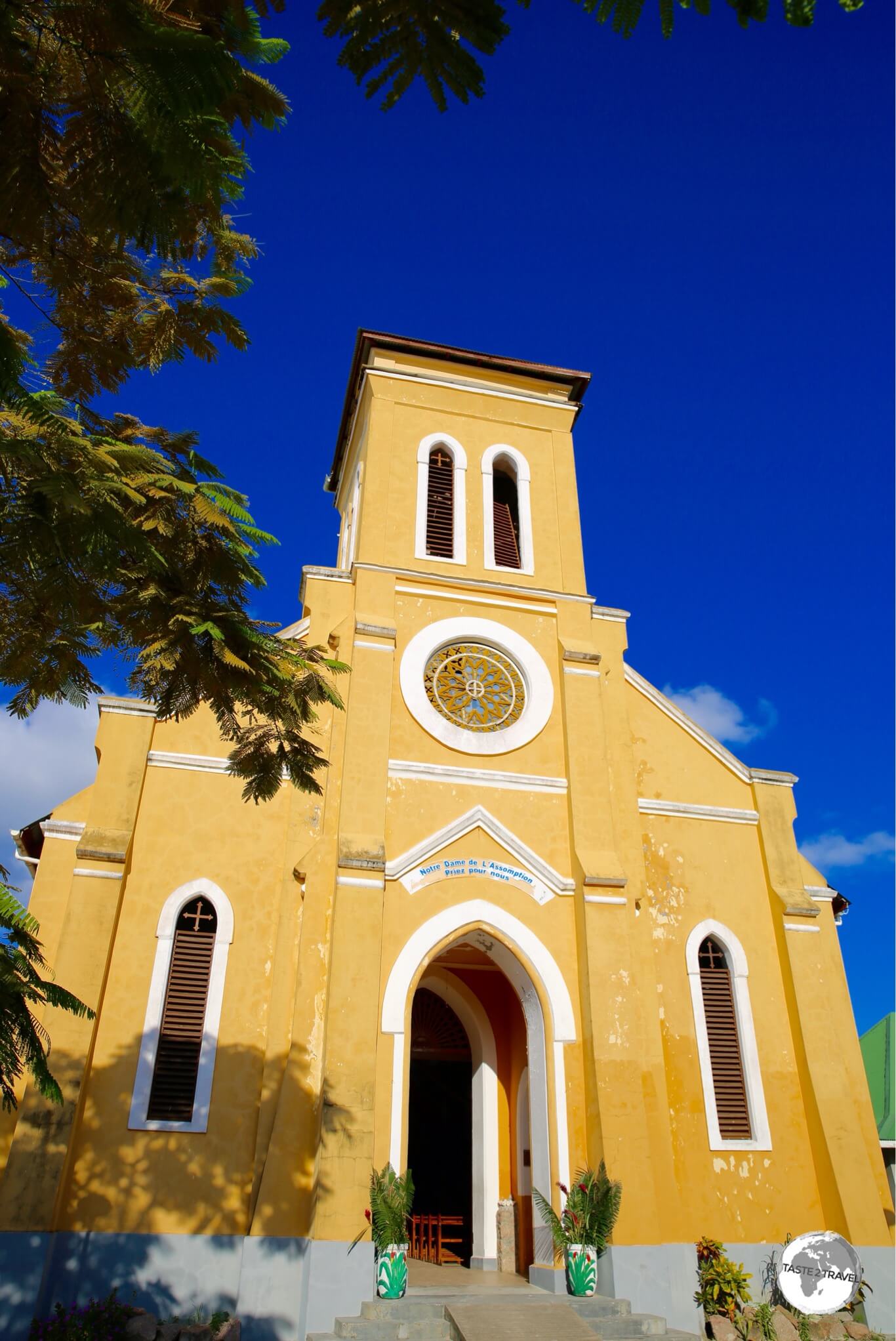
Impossible to miss, the bright-yellow Notre Dame de L’Assomption Church dominates the waterfront on La Digue Island.
Located on the waterfront, south of the ferry pier, the Notre Dame de L’Assomption Church is impossible to miss, thanks to its striking yellow façade.

The interior of the Notre Dame de L’Assomption Church on La Digue Island.
On an island brimming with beautiful natural attractions, this attractive, but simple, church is the one man-made sight worth a quick visit. Built in 1854, the church was the first Catholic church on the island.
Accommodation

Elje Villa, my favourite guest house on La Digue Island.
There’s no shortage of accommodation on the main islands of the Seychelles, although budget options are limited. If you’re travelling on a budget, an apartment rental through Airbnb is a good option. On the popular tourist island of La Digue, many families offer deluxe guest house accommodation at reasonable prices.
Mahé
While on Mahé, I stayed in two different properties on either side of the island. On the east coast, I stayed at the wonderful La Villa Therese which is located one block back from the amazingly beautiful beach at Anse Royale. This small, family-run, holiday apartment complex offers spacious apartments with all facilities, which allows for self-catering.
Apartments can be booked online through sites such as Hotels.com for around US$95 per night.
On the west coast I stayed in an Airbnb apartment in the popular tourist enclave of Beau Vallon. The apartment house is located in a quiet backstreet and features a variety of apartments from one-bedroom (USD$120 per night) to a deluxe 2-bedroom apartment (USD$200 per night). Clean and spacious, the apartments are owned and managed by the wonderful Beryl, who is a rated as a Super-host on Airbnb.
Both accommodation options are best suited to those who have their own transport, which is always best on the Seychelles.
Praslin
While on Praslin, I stayed at the amazingly beautiful beach-side village of Anse Volbert, in the less-than-spectacular Villa Bananier Guest House.
Located a short stroll from the white-sands of Anse Volbert, Villa Bananier is a 2-story house which offers eight, old and dated rooms. A standard room, with breakfast, costs US$95 per night while the same room with half board costs US$120 per night. There are many excellent restaurants along the beach front so the half board option is not necessary.
La Digue

My colourful room at Elje Villa on the island of La Digue.
There are many accommodation options on the popular island of La Digue. The back lane-ways of the main town are lined with newly constructed, family-run, guest houses, offering comfortable, stylish accommodation.

My beautiful bathroom at Elje Villa.
While on the island, I stayed at the very new, sparkling clean, Elje Villa which is located on a quiet lane-way, a short walk from the dock, restaurants etc.
Operated by the wonderful Elna, the guest house includes lots of thoughtful touches such as fresh cut flowers in the bathroom with local, natural, materials incorporated into the design of each room. Rooms, which start at US$93 per night, can be booked on booking.com
Eating Out

Local fish can be found on most restaurant menus.
As can be expected from an island nation, seafood features prominently on restaurant menus in the Seychelles. The fishing industry is the 2nd largest economic activity in the Seychelles, with Victoria being home to one of the largest Tuna canneries in the world.
One thing you will not find in the Seychelles are the usual global fast food outlets like McDonald’s or KFC. One exception to the rule is a Burger King outlet, which can be found in the departure lounge of the international terminal, making it only available to travellers and not the general public.
While the international chains are barred, a local version of McDonald’s – Butcher’s Grill – serves burgers, kebabs, fried chicken and other fast food from its outlet in downtown Victoria.
Restaurants

Red snapper is very popular in the Seychelles, and can be sampled everywhere, including at the Pirogue restaurant on Praslin.
The restaurants in the Seychelles are known for their international and Creole cuisine. Seafood dominates menus with Red snapper being especially popular. There are a multitude of restaurants with a diverse variety of styles, from casual to fine dining, catering for all budgets. As most food is imported, menu prices are high. A good restaurant directory is provided by Lonely Planet.
Many service staff in the Seychelles are guest workers, with males being recruited from India or the Philippines and females being recruited from the Philippines or English speaking countries of Africa such as Kenya and Cameroon.
Mahé
Victoria
While you can dine inside, the alfresco courtyard is the place to be. A new branch of the restaurant has recently opened on the beach at Beau Vallon, which is fantastic news, as they offer breakfast, which was previously impossible to find in Beau Vallon.
Praslin
While on Praslin, I sampled many restaurants, but kept returning to the very popular Pirogue restaurant, which is located across the road from Anse Volbert beach.
Specialising in Creole cuisine, this is a great place to sample typical Seychellois dishes. The photo above shows a grilled red snapper which was my lunch on one occasion. Open daily from 8.00 am to 11 pm, the Pirogue serves breakfast, lunch and dinner.
La Digue
It often seems that my favourite restaurant is the most expensive, and this is very much the case with Le Repaire, which offers the finest dining on La Digue and, possibly, the best Italian food anywhere in the Seychelles.
Despite the high prices (Spaghetti Carbonara for US$23), I dream of one day returning to La Digue to indulge in more fine Italian fare at this beachfront restaurant.
A stylish, art-filled, establishment, the restaurant is under the command of an Italian chef who imports many of the key ingredients from Italy. The menu includes the tastiest wood-fired pizzas, homemade pasta, meat dishes and local fish dishes with everything executed to perfection.
I recommend starting with the Insalata Caprese – truly divine! The dessert menu changes daily, but always includes Italian favourites such as Tiramisu and Pannacotta.
As is to be expected from an Italian establishment, the restaurant opens for breakfast (7 am – 9:30 am) then closes, reopening for lunch and dinner from 12:30 pm to 10:00 pm.
Cafés

Whole Foods in the Seychelles? This is not the US supermarket chain but an excellent convenience store and café on Praslin.
Coffee culture on the Seychelles is not well established, with most places serving mediocre brews.
My favourite cafés include:
Mahé
Coffee Club – Possibly the best café in the whole country, the popular Australian coffee chain, Coffee Club can be found in the arrivals area of the airport. What differentiates it from other coffee chains is the table service, excellent food and drinks menu and the strong flavour of their coffee, which is roasted in Australia.
Praslin
Whole Foods Café – The first time I drove through the tiny, sleepy village of Amitie, I did a double-take. Whole Foods in the Seychelles? And on Praslin? I had to investigate!
This is no relation to the US supermarket chain, but is the brainchild of a South African entrepreneur who saw an opening in the market for both a quality convenience store and a café.
Open for lunch, the café menu includes very tasty sandwiches, wraps, meat pies, milkshakes and Illy coffee. Once I had sampled their offerings, I made a point of returning each day, to sample more. The meat pies are especially recommended but sell out fast, while their coffee is the best on Praslin.
Whole Foods is part of the adjacent Ocean Jewel Resorts which is located directly on the white sand beach.
Bars

SeyBrew lager is the #1 selling beer in the Seychelles.
Despite the fact that alcohol is freely available, and the Seychelles is full of thirsty tourists, there are surprisingly very few bars in the country.
While most restaurants serve alcohol with meals, the only bars I saw were in the tourist enclave of Beau Vallon. One lively bar, which can be found across from the beach, is the Boat House Restaurant.
Locals wanting a drink tend to congregate in the evenings around their local corner store where they can purchase affordable beers. The most popular beer in the Seychelles is SeyBrew lager, which is brewed by Seychelles Brewery. The brewery is owned by the giant Diego company, who, unfortunately, add sugar to the mix in order to accelerate the brewing process. Despite this, the beer is very quaffable and refreshing.
My favourite drinks on the Seychelles normally included a shot of the exquisite Takamaka rum. A visit to the distillery (see ‘Sightseeing‘ section above) provides an opportunity to sample some interesting cocktails.
Visa Requirements

The Seychelles passport stamp features a ‘Coco de Mer’ design.
The Visa Policy of the Seychelles is wonderfully straight-forward, with all nationalities entitled to visa-free entry. The only requirements for entry are that you are in possession of a valid passport, return or onward ticket, proof of accommodation and sufficient funds. These requirements are strictly enforced!
Immigration
For a country which is so reliant on tourism, you would think the immigration officers at Seychelles International airport would be more welcoming to tourists.
Upon arrival, I was asked to show my return ticket and hotel bookings for each of the nights I intended to stay. I always travel ‘sans itinerary‘ and only create a travel plan for each destination after meeting with local tourism officials.
I used this reason to explain why I had only booked the first two nights on Mahé and this was accepted by the immigration officer.
Despite the fact that the official policy states that visitor’s will be granted a 3 month stay, the reality is that you will be granted a stay up to the date of your onward flight.
Getting There
Air
All flights into the Seychelles arrive at Seychelles International Airport, which is located on the east coast of Mahé, 10 km south of the capital. Apart from cruise ship, this is the only gateway to the country.
The following airlines provide scheduled flights from Seychelles International Airport:
- Air Austral – flies to/ from Saint–Denis de la Réunion
- Air Mauritius – flies to/ from Mauritius
- Air Seychelles – flies to/ from Johannesburg–O. R. Tambo, Mauritius, Mumbai, Praslin Island, Tel Aviv
- British Airways – flies to/ from London–Heathrow
- Condor – flies to/ from Frankfurt
- Emirates – flies to/ from Dubai–International
- Ethiopian Airlines – flies to/ from Addis Ababa
- Etihad Airways – flies to/ from Abu Dhabi
- Kenya Airways – flies to/ from Nairobi–Jomo Kenyatta
- Qatar Airways – flies to/ from Doha
- SriLankan Airlines – flies to/ from Colombo–Bandaranaike
- Turkish Airlines – flies to/ from Istanbul
The airport serves as the base for the national carrier, Air Seychelles, who offer domestic (charter) flights to the following destinations:
- Alphonse Island
- Bird Island
- D’Arros Island
- Denis Island
- Desroches Island
- Frégate Island
Airport Transport
Public bus 1C, stops outside the airport on its way north and south along the east coast. Operated by the Seychelles Public Transport Corporation (SPTC), a single ticket costs Rs 7 (USD$0.50), which can be purchased from the driver.
Apart from the public bus, you have the option of renting a car directly at the airport (the recommended option) or taking a taxi from the rank in front of the arrivals area (see the ‘Getting Around‘ section below for more on taxis).
Cruise Ships
The Seychelles is a popular port of call for visiting Cruise ships, with 64 ships calling into Mahé during the cruise season, which lasts from October to March.
Getting Around
Public Transport
Seychelles Public Transport Corporation (SPTC) is the sole provider of public transportation services in the Seychelles. Bus services are offered on both Mahé and Praslin islands with a single ticket costing Rs 7 (USD$0.50) during the day and Rs 10 after 8 pm. Details on routes and schedules are available for download from their website.
Taxi
Best to be avoided!
In a country where Uber does not exist, you can be sure of high taxi fares. Unlike other countries, where the taxi business is owned by companies, in the Seychelles, taxi drivers own their own business. Currently there are 372 licensed taxi drivers operating on the three main islands of Mahé, Praslin and La Digue. There are no meters and most drivers are specialists in price gouging tourists.
I once took a taxi from the airport to the capital and paid dearly. I had a discussion with the driver regarding the introduction of external competition such as Uber. He was adamant that Uber would never be allowed to enter the local market.
He was correct, but a recent local version of Uber – Bouzāy – has been introduced and is hopefully the disruptor that locals and tourists have been waiting for. The app is currently only available on the Android platform on Google Play but plans are afoot to introduce an iOS version for Apple products.
Ferry

Departing Praslin island for La Digue, aboard the Cat Cocos ferry.
Ferry services between the three main islands, Mahé, Praslin and La Digue, are provided by Cat Cocos Inter-Island Ferry, who operate a fleet of four high-speed catamaran ferries. Tickets can be booked from the company offices, which are located at each of the island docks. Current prices and the schedule are available from their website.

The Cat Cocos ferry route map.
Source: catcocos.com
The sailing time from Mahé to Praslin is 1 hour, while the short hop from Praslin to La Digue takes just 15 minutes. A one-way fare from Mahé to Praslin is €50 (USD$55), while a return ticket costs €100 (USD$110).
Rental Car

My rental car on Mahé, the best option for exploring the island.
Mahé
With a patchy bus service, the only way to sensibly explore the main island of Mahé is with a rental car. There are numerous agents at the airport and it’s recommended to collect a car upon arrival. There are limited cars available so it’s best to book in advance.
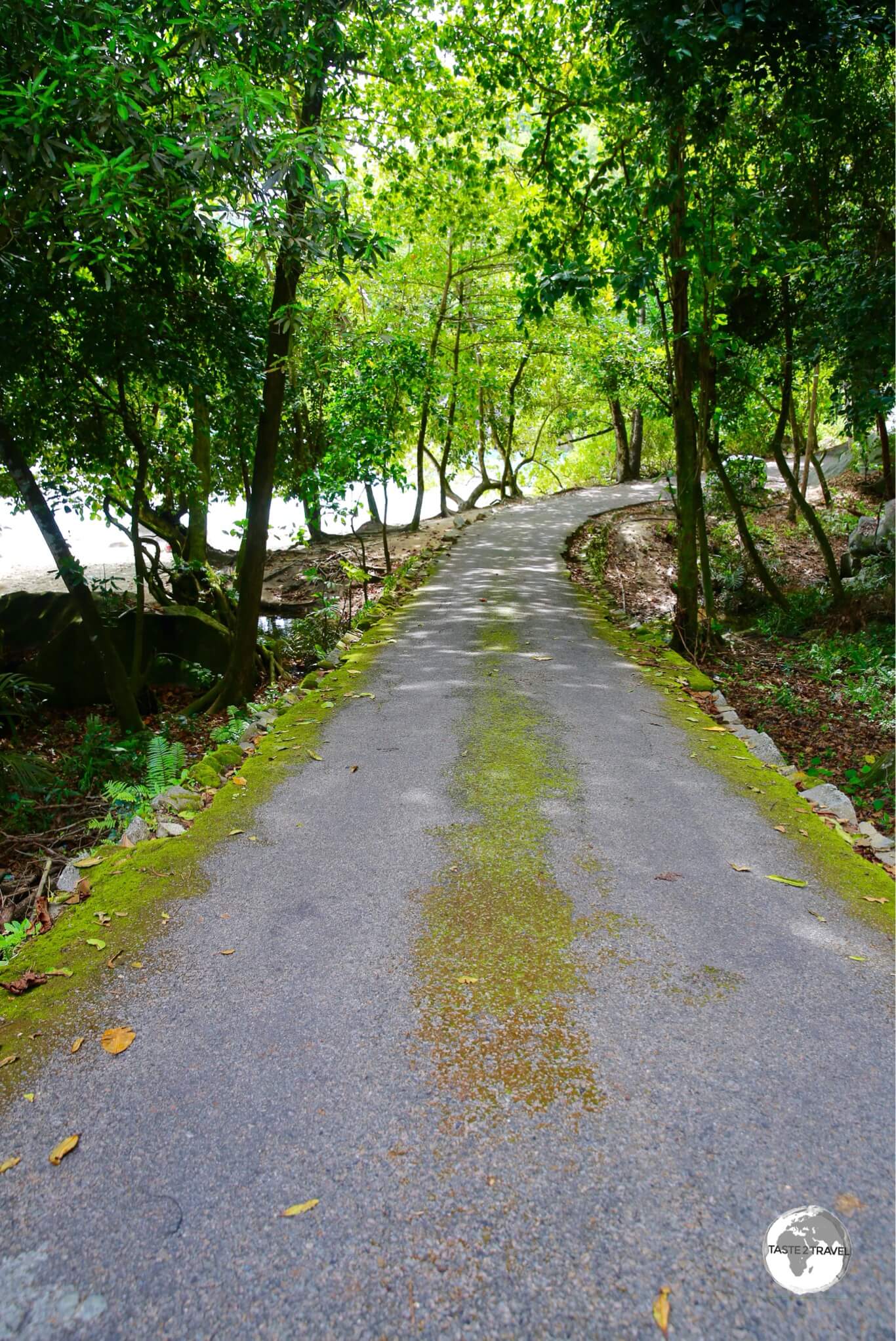
Some roads on the Seychelles can be challenging such as this two-way road (which is one lane wide), with steep drop-offs on either side.
I rented a compact car through Hertz (USD$65 per day), which I collected at the airport upon arrival. One benefit with renting through Hertz was that I could use their Head Office car park, free of charge, which is located on Revolution Avenue in downtown Victoria, a city with very limited parking spaces.
Praslin

Exploring Praslin Island in my rental car, the only sensible option for exploring this slice of paradise.
The bus service on Praslin is even less-reliable, making a rental car the only option to explore this stunning island. There are many agents on Praslin, especially in the Anse Volbert neighbourhood. I organised a car through my accommodation, Villa Bananier Guest House.

The license plate of my rental car on Praslin.
This is the end of my Seychelles Travel Guide.
Safe Travels!
Darren
Follow me on Instagram:
[instagram-feed feed=1]
Further Reading
You might also be interested in reading other taste2travel articles from the region, such as my:
Seychelles Travel Guide Seychelles Travel Guide Seychelles Travel Guide Seychelles Travel Guide Seychelles Travel Guide
Seychelles Travel Guide Seychelles Travel Guide Seychelles Travel Guide Seychelles Travel Guide Seychelles Travel Guide
Seychelles Travel Guide Seychelles Travel Guide Seychelles Travel Guide Seychelles Travel Guide Seychelles Travel Guide
Seychelles Travel Guide Seychelles Travel Guide Seychelles Travel Guide Seychelles Travel Guide Seychelles Travel Guide
Seychelles Travel Guide Seychelles Travel Guide Seychelles Travel Guide Seychelles Travel Guide Seychelles Travel Guide




